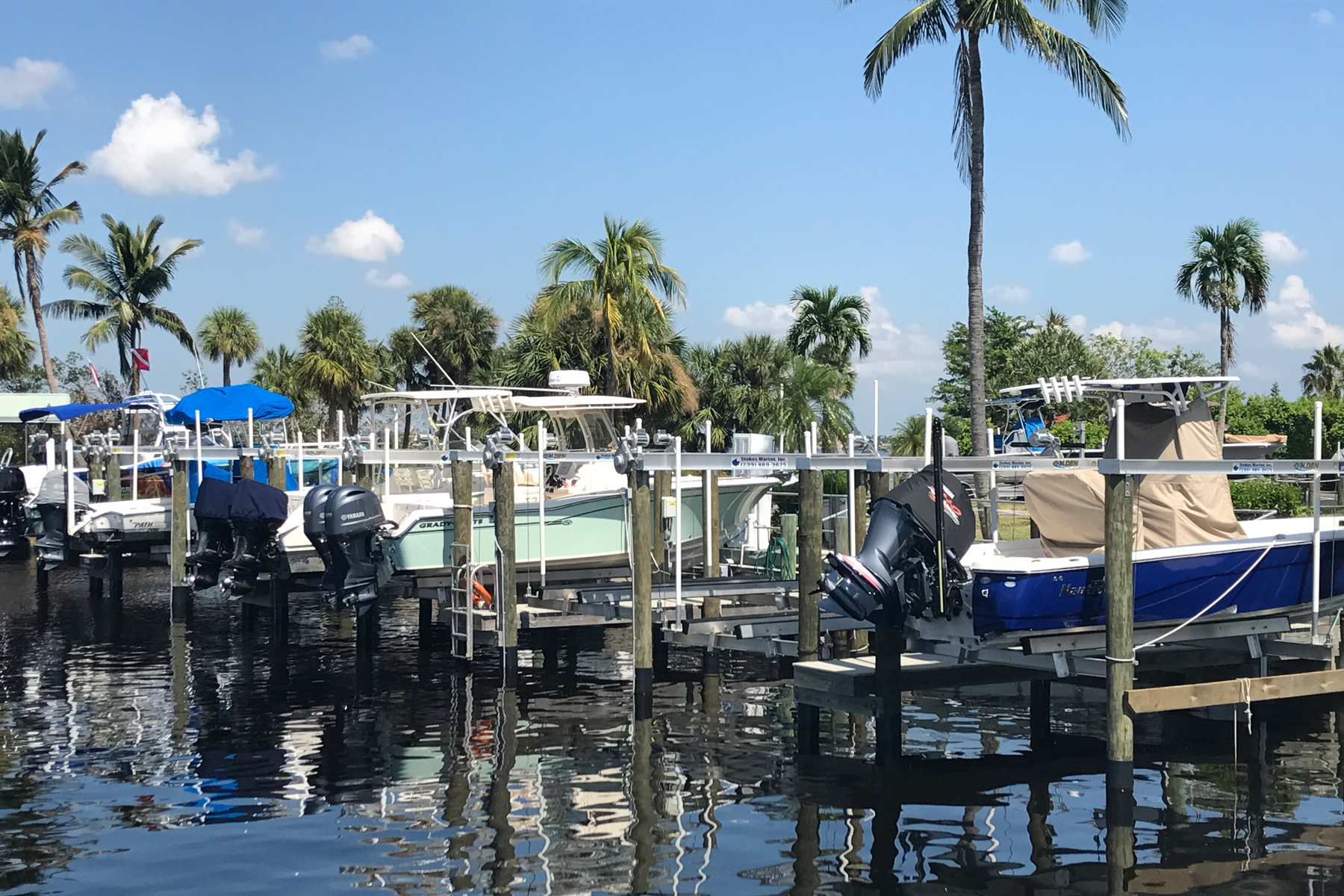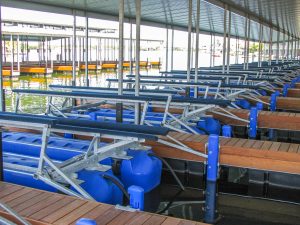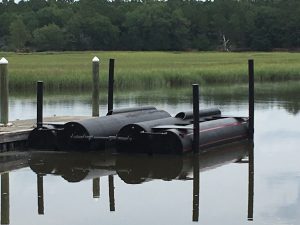
Boaters Drive Demand for Lifts at Slips
Published on June 26, 2018Tidal fluctuation, storm risk, passing wakes, bottom material and water depth are all variables that have been considered by marina owners when choosing what type of docks to install. Some of those same variables, along with considerations of the types of boats that will be served, now play into the choice of what boatlift is most appropriate. As more customers request boatlifts, more marina operators see the value or even profit in installing lifts.
What should a marina owner consider if boatlifts are to become part of the infrastructure? For Scott Mauldin, regional director of the Southeast for HydroHoist Boat Lifts, the first question in deciding to put in a lift really comes from a boat owner, “Why do I need a boat lift?”
“For boaters that are true boaters, passionate about it, a boatlift will enhance every part of boating. They don’t just protect but give quicker access to the water. It protects and maximizes use,” Mauldin said.
For many marinas, customer demand is what drives the installation of boatlifts. Some facilities opt to put one in only at an owner’s request, while others install lifts as part of the marina infrastructure and fill them on a first-come, first-serve basis.
Regional Demand
Demand for boatlifts differs by region. Inland marinas in the south are very popular locations for boatlift installations.
“I get several inquiries each year now by people with wake board type boats

who want to keep their boats clean. The cleanliness is a big thing but also there’s a lot less worry because the lift is locked so an engine won’t disappear or a boat float away,” said Tom Allen, assistant manager at Sunset Marina on Dale Hollow Lake in Tennessee. He said about a quarter of his boats are in lifts.
“The depth of the lake is about 50 to 60 feet on average so it’s easy to anchor the lifts to the bottom and adjust to rising and falling lake levels. We have some customers that purchase their own lifts and others who rent. Sometimes they bring their old lift from another marina and just install it here,” Allen said. The largest lift at Sunset Marina is a 16,000-pound capacity for a vessel about 34 feet.
Mistie Mauldin of Center Hill Marina on Center Hill Lake agrees that boatlifts are popular. The marina has about 600 slips and nearly half have lifts. “It (the lift) definitely keeps the boats cleaner especially in some of the lakes here that are pretty dirty. The lift helps maintain the exteriors. Some of our lifts are up to 20 or even 30 years old,” Mauldin said.
The marina either sells or rents the lifts to the customer. If customers buy the lift, the marina charges a connection fee for the power that the customer will use and wear and tear from having the lift attached to the marina’s docks. For rentals, the fee to rent the lift is in addition to the slip rental fee. In either instance the lifts prove profitable for the marina.
Both marina operators say maintenance on boatlifts is minimal.
“I can’t remember the last time I had any major issue with a lift. The motors go now and again, but they’re inexpensive and easy to install. We do repairs on the lifts we sell, otherwise the customers go through the dealers of the lifts,” Allen said.
Types of Lifts
According to Bill Golden, president of Golden Boat Lifts, lifts were originally used in the mid 1960s at boatyards and government sites for new boat launching or for repairing hulls. The use of lifts for individual slips only began about 50 years ago.
There are now several different types of lifts that operate in differing ways, and are built for varying boat docking infrastructure, as well as water types and boat sizes.
“For marinas mainly, we use our 4-post boatlifts. We have 4-post lifts up to 56,000 pounds. Generally, marinas that are floating where you can’t put piling in would require something that floats. Deep lakes would tend to have floating boatlifts. Rocky shores with shallow waters might be using elevators, soft bottomed waters that have piles in place will have post lifts. These are the strongest and best dollar for dollar pound for pound. Best warranty savings. The lift is determined by the environment,” Golden said.
In a suspended cable and post system, the piles support the weight of boat. There is a cross beam with a pulley system where the cable runs through either a manual or electric powered winch, to the pully to the cradle that pulls boat. Piles do need to be substantial enough to carry the weight of the dock and lift with the boat in it.
In looking at the size lift required, “Two things you have to consider is total wet weight and proper hull support. Doesn’t matter if it’s a 15-foot jon boat or 48-foot cruiser,” Mauldin said. He explained that the lift has to support the weight of the boat, but the dock that the lift is attached to will have to support the weight of the lift and the weight of the boat. “When lifts are submerged that load is transferred to the dock which can be a burden on the structure,” he said.
A newer option for post systems are platform mount or deck lift systems, where the entire platform raises and lowers bringing the boat completely out of the water to sit on the platform. The platform when lowered just becomes part of the overall decking.
“Deck lifts are becoming very popular especially over the past five years. The deck sits on top of the cradle of our 4-post lift and the boat goes on top of deck. It can serve jet skis, kayaks or whatever craft is wanted,” Golden said. “The frame is under water supported by dock. Press the remote and the boat is lowered into the water with three sides of the boat surrounded by dock. This gives very easy access to the boat.”
Where piles do not exist, there are options for a freestanding lift or a floating lift. Free standing lifts attach directly to the sea floor so the only parts visible are the boat supports. The limiting factor for where they can be placed is water depth with a maximum of about 20 feet. The type of bottom also plays some role, as these will work better in semi-soft ground than in a rock or mud bottom. Free-standing is a term sometimes used interchangeably with hydraulic lift although one phrase refers to the stand while the other refers to the power. Traditionally, these have been used only in freshwater lakes since the base remains submerged and saltwater would be detrimental. However, there are innovations on the hydraulic front.
“Hydraulic lifts have been in the past used only for freshwater, but I made changes and applied for patents to make the freshwater hydraulic lift into a saltwater lift. An air bellow prevents water from getting onto hydraulic shafts, which is better for seals and overall operation. We expect it (the hydraulic lift) to grow four to five times what it is today and meet the level of sales of electric systems,” Golden said. “Hydraulic lifts are very fast and they disappear. The only thing you ever see are boat supports above water. They are popular because they are very sleek and almost invisible and can carry pontoons to speed boats.”
Prior to hydraulic lifts, boats were lifted through a cable and winch system. A wheel could be turned manually to raise and lower the boat, which was cost effective and practical in places without power options; however, the process is slow, and the lift has to remain submerged while the boat is out. The electric winch system works on the same cable principal but electricity powers the cable, and through remote controls, the lift can be raised and lowered from the water. This option is more practical and faster and still the most widely used.
Going beyond the cable and winch system is the floating lift. For floating lifts, “the air tank is the heartbeat of the entire structure,” Mauldin said. “You can have any multiple number of tanks. Inflating the air tanks creates buoyancy that floats and raises the boat. The tank is flooded by water when you open the valve and let air escape. The tank submerges low enough to float the boat. Pull in the boat, align with lines, turn on the blower, air enters the tank and pushes water out of bottom. When the water is displaced, the tanks gain buoyancy and raise the boat back out of the water.”
A newer floating boatlift was introduced in 2013 by Chuck Gorgen of DryDock

Lift Systems. He built his prototype to solve the issue of needing to keep his boat up and out of nutrient-rich saltwater of the Georgia Bight, but needed a lift that could withstand the rust and corrosion that saltwater introduces. He chose a military grade high density polyethylene that has no bolts or other rusting parts. It relies on welding and pins. “These floats don’t rely on air pressure but air volume. Open the valve to let the air escape and the floats sink, pump air in and they float,” Gorgen said. The lifts can sit in shallow water, as they only need 3 feet of clearance past the depth of the vessel, and they can float in the deepest water. The lift raises the boat five inches from the water’s surface.
Gorgen thinks a floating lift is the answer to what he sees as a booming interest in much larger outboard boats. “These vessels are stern heavy so require lifts that can counterbalance that weight further to the bow of the boat than the center,” Gorgen said. As he custom makes each of his lifts for the boat, Gorgen can adjust for this to maintain the center of buoyancy of the lift just forward of the center of gravity for the boat. In early June, he launched his largest lift at 25,000 pound for a 42-foot power boat.
Looking Ahead
While hydraulic lifts are the newest innovation, more could be coming.
“We are exploring hydraulics built into floating docks. We completed this in the Maldives, a floating lift with hydraulics, for a submarine. It can be done and we’re looking into it more,” Golden said. “You turn on the air pump to add air and push water out the bottom. Floating lift is built into the floating dock system. We’ve already patented the plastic floats with the aluminum frame with cable lift built right in.”
Lifts have evolved to accommodate the needs and wants of boaters and likely the future of lifts will depend on future boat designs. There may not soon be marinas that have a lift in every slip, but the popularity will likely increase and may eventually dictate overall design of future marinas to accommodate the latest in lift innovations.
| Categories | |
| Tags |





